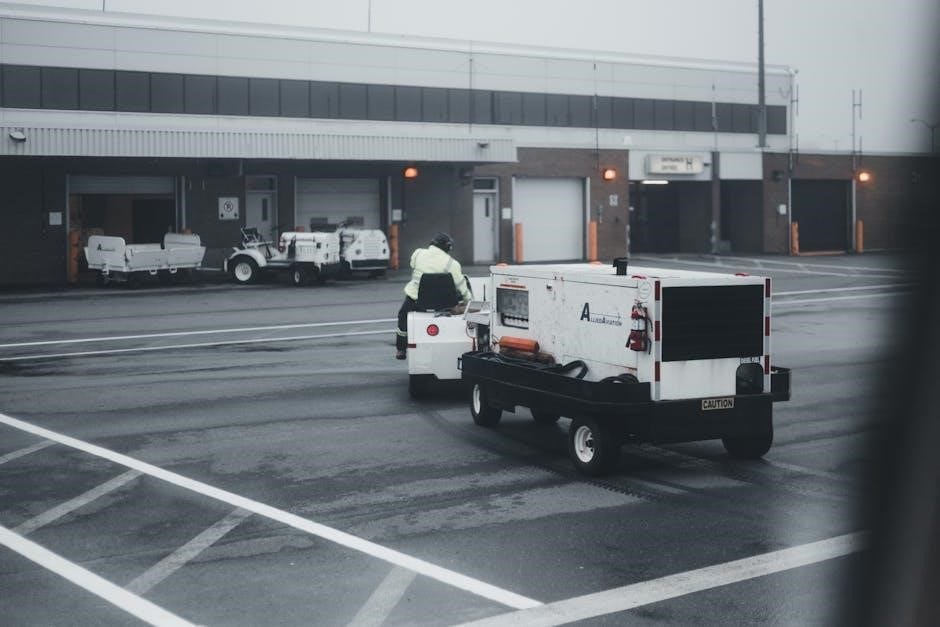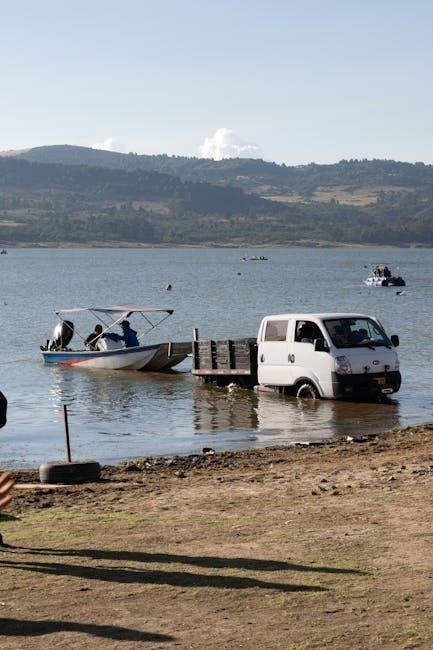trailer tow guide
Discover the best tips and tricks for safe and efficient trailer towing. Learn how to choose the right equipment and master the techniques for a hassle-free experience.
Trailer towing safety is crucial for preventing accidents and ensuring a smooth journey. Proper vehicle-trailer compatibility, safe driving practices, and regular maintenance are essential for a secure towing experience.
1.1 Importance of Safe Towing Practices
Safe towing practices are critical to prevent accidents, ensure stability, and protect both the vehicle and trailer. Proper techniques reduce risks, enhance control, and comply with legal requirements, making every journey secure and stress-free for drivers and other road users.
1.2 Key Considerations for Beginners
For beginners, understanding towing capacity, proper hitch installation, and load balancing is vital. Ensuring trailer brakes function correctly and practicing towing in a safe environment can build confidence and prevent potential hazards on the road. Regular checks of tires, lights, and connections are also essential for safe towing experiences.
Understanding Towing Capacity
Towing capacity is the maximum weight your vehicle can safely tow. It includes the trailer, cargo, and passengers, ensuring safe and controlled towing without risking vehicle damage.
2.1 Calculating Your Vehicle’s Towing Capacity
To calculate your vehicle’s towing capacity, refer to the manufacturer’s guidelines, which include the Gross Vehicle Weight Rating (GVWR) and Gross Combined Weight Rating (GCWR). Subtract the vehicle’s curb weight from the GCWR to determine the maximum trailer weight, ensuring safe and efficient towing without overloading the vehicle.
2.2 Factors Affecting Towing Capacity
Towing capacity is influenced by trailer weight, passenger load, added accessories, and fluids. Exceeding the vehicle’s GVWR or GCWR risks instability and damage. Proper calculation ensures safety, while overloaded trailers can compromise control and braking efficiency, emphasizing the need for accurate assessments before towing.

2.3 Vehicle Specifications and Towing Limits
Vehicle specifications, including GVWR, GCVWR, and tongue weight, dictate towing limits. Consult your owner’s manual for precise ratings. Exceeding these limits can lead to reduced control and potential safety hazards, emphasizing the importance of adhering to manufacturer guidelines for secure towing.

Essential Trailer Components
Key components include the hitch, coupler, brake systems, wheels, tires, and suspension. These elements ensure stability, control, and safety while towing, requiring regular inspection and maintenance.
3.1 Trailer Hitch and Coupler Types
Trailer hitches vary, including ball, fifth-wheel, and gooseneck types. Each suits different towing needs, ensuring compatibility with vehicle capacity and trailer weight. Ball hitches are common for lighter loads, while fifth-wheel and gooseneck hitches handle heavier trailers. Proper hitch selection is vital for safety and stability. Always match hitch type to trailer requirements.
3.2 Brake Systems and Controllers
Proper brake systems are vital for safe towing. Trailer brake controllers regulate braking force, ensuring synchronized stops. Manual activation tests braking effectiveness, adjusting gain to prevent wheel lock-up. Correct setup enhances control and safety, reducing the risk of accidents during towing. Always ensure compatibility with your vehicle and trailer specifications.
3.3 Wheels, Tires, and Suspension
Properly maintained wheels, tires, and suspension are critical for trailer towing safety. Ensure tires are inflated to recommended pressures and free from cracks or wear. Regularly inspect suspension components for damage or sagging. Secure wheels with tight lug nuts and check for alignment issues to maintain stability and control while towing.

Pre-Towing Safety Checks
Inspect trailer lights, electrical connections, and tire condition. Ensure hitch alignment, brake systems, and suspension are secure. Verify tire pressure and test brakes before towing.
4.1 inspecting Trailer Lights and Electrical Connections
4.1 Inspecting Trailer Lights and Electrical Connections
Ensure all trailer lights function properly, including brake, turn signals, and running lights. Check electrical connections for damage or corrosion. Verify the trailer plug matches your vehicle’s socket. Secure loose wires and test signals to confirm proper communication between the vehicle and trailer systems before towing.
4.2 Checking Tire Pressure and Condition
Always check trailer tire pressure using a pressure gauge, ensuring it matches the manufacturer’s recommended levels. Inspect tires for wear, damage, or uneven tread. Replace worn-out tires and ensure proper inflation to maintain stability and safety while towing. Address any signs of uneven wear promptly to prevent failures during transit.
4.3 Ensuring Proper Hitch Alignment and Security
Proper hitch alignment ensures safe towing. Always check the hitch pin and ball for tightness and ensure the coupler is securely locked. Verify that the trailer aligns straight with the vehicle to prevent sway. Test the connection by gently pulling forward and ensure no movement occurs. Never exceed hitch weight limits.
Hitching Up the Trailer
Hitching up a trailer involves aligning the vehicle and trailer, securing the coupler to the hitch, and attaching safety chains. Always ensure proper alignment and secure connections.
To attach the trailer, align your vehicle with the trailer, ensuring the hitch and coupler are compatible. Lower the trailer onto the hitch ball, secure the coupler, and tighten the latch. Attach the safety chains and connect the electrical harness. Finally, check all connections for tightness and proper function before towing. Ensure the coupler is fully engaged on the hitch ball and locked in place. Insert the hitch pin through the receiver and secure it with a clip or lock. Double-check that all connections are tight and properly aligned to prevent accidental detachment while towing. Safety chains should also be attached. Connect the brake controller to your vehicle’s braking system for synchronized stopping. Attach safety chains to both the trailer and vehicle, ensuring they can help maintain control if the trailer disconnects. Properly route and secure chains to avoid dragging or obstructing movement during towing. This enhances overall safety. Properly loading your trailer ensures stability and safety. Distribute weight evenly, secure cargo firmly, and avoid overloading to maintain control while towing. Balancing the load is critical for trailer stability. Distribute weight evenly from side to side and front to back. Place heavier items near the axle and secure them tightly. Avoid overloading the tongue, as this can affect vehicle control and trailer maneuverability during towing. Proper balance ensures safe and stable transport. Properly securing cargo is vital to prevent shifting during transit. Use high-quality straps, tie-downs, and covers to keep items firmly in place. Ensure cargo is evenly distributed and tightly fastened to avoid movement. Failure to secure cargo can lead to instability, accidents, or damage. Always double-check tie-downs before towing. Overloading a trailer is dangerous and can lead to instability, brake failure, or loss of control. Always check the trailer’s GVWR and ensure the total weight, including cargo and fluids, does not exceed it. Properly distribute the load and avoid adding extra weight beyond the recommended capacity for safe towing. When towing, accelerate smoothly, avoid sharp turns, and maintain a safe distance. Use mirrors constantly and downshift before hills to control speed and stability. Adjust your driving techniques to account for the added weight and length of the trailer. Accelerate gradually and avoid sudden movements. Use brake controllers to maintain control and ensure smooth stops. Always be aware of your surroundings and anticipate potential hazards. Safe towing requires patience, focus, and consistent practice. Maintaining a safe following distance is critical when towing a trailer. Allow extra space to account for the increased stopping distance. Double the usual gap to ensure time to react and avoid collisions. Adjust your speed and be cautious in adverse weather conditions to enhance safety on the road. When towing, handle turns with care. Always signal early, slow down before turning, and avoid sharp movements. Use mirrors to monitor the trailer’s position. Apply brakes gradually to prevent swaying. Smooth acceleration and steady steering help maintain control. Practice in open spaces to build confidence and reflexes for safer towing experiences. Regular trailer maintenance ensures safety and longevity. Inspect tires, brakes, and electrical connections. Lubricate moving parts and check for wear. Address issues promptly to prevent breakdowns. A regular maintenance schedule for trailers includes monthly inspections of tires, brakes, and electrical systems. Lubricate hitch and suspension components quarterly. Annual checks involve inspecting the frame, axles, and coupler. Addressing wear and tear promptly ensures reliability and safety during towing. Schedule professional inspections if unsure about any component’s condition. Inspecting and replacing worn parts is critical for trailer safety. Check tires for wear, brakes for function, and electrical connections for corrosion. Replace any damaged or worn components promptly. Use high-quality replacement parts that meet manufacturer specifications to ensure reliability and prevent potential failures during towing. Always follow a routine inspection checklist for thoroughness. Proper storage protects your trailer from damage. Choose a dry, level area away from hazards. Secure the trailer with locks and stabilizers to prevent theft and movement. Cover tires to shield them from UV exposure and store electrical components in a dry place. Regularly inspect stored trailers for signs of wear or pests. Selecting the correct hitch and equipment ensures safe and efficient towing. Match your hitch type to your vehicle and trailer specifications for optimal compatibility and performance.5.1 Steps to Attach the Trailer to Your Vehicle

5.2 Securing the Coupler and Hitch Pin
5.3 Connecting Brake Controllers and Safety Chains

Loading the Trailer Correctly
6.1 Balancing the Load for Stability
6.2 Securing Cargo to Prevent Shifting
6.3 Avoiding Overloading the Trailer
Driving Tips for Towing a Trailer
7.1 Adjusting Driving Techniques for Towing
7.2 Maintaining Safe Following Distances
7.3 Handling Turns and Braking

Trailer Maintenance and Upkeep
8.1 Regular Maintenance Schedule
8.2 Inspecting and Replacing Worn Parts
8.3 Storing the Trailer When Not in Use

Choosing the Right Hitch and Equipment
9.1 Types of Trailer Hitches
9.2 Selecting the Correct Ball Mount and Hitch Ball
Choosing the right ball mount and hitch ball ensures proper trailer alignment and safety. The ball mount must match the trailer’s height, while the hitch ball’s size should fit the coupler. Both components must be rated for the trailer’s weight to prevent failure during towing.
9.3 Accessories for Enhanced Towing Safety
Essential towing accessories include brake controllers, weight distribution systems, and sway control devices. These enhance stability and control, reducing the risk of trailer sway and improving braking performance. They ensure a safer and more comfortable towing experience, especially for heavier loads and long-distance trips.
Legal and Regulatory Considerations
Understanding regional towing laws, weight restrictions, and licensing requirements is vital for compliance. Ensure your setup meets legal standards to avoid penalties and ensure safe towing practices.
10.1 Towing Laws and Regulations by Region
Understanding regional towing laws and regulations is essential for safe and legal towing. Weight and size restrictions, driver licensing requirements, and trailer type specifications vary by region. Penalties for non-compliance can be severe, so always check local regulations before towing. These laws ensure road safety and protect both drivers and other road users.
10.2 Licensing Requirements for Towing
Licensing requirements for towing vary by region and depend on the trailer’s weight and type. In some areas, a special license is needed for trailers exceeding certain weight limits. For example, in the UK, licenses issued before 1997 allow towing heavier trailers, while newer licenses may require additional certifications. Always check local regulations to ensure compliance.
10.4 Understanding Weight and Size Restrictions
Weight and size restrictions for towing vary by region and are enforced to ensure road safety. Always check local laws regarding trailer dimensions and weight limits. Exceeding these can lead to legal penalties and safety hazards. Use your vehicle’s GVWR and GCVWR as guides to stay compliant and avoid risks.

Troubleshooting Common Towing Issues
Identify and address issues like trailer sway, brake malfunctions, or tire failures promptly. Regular checks and proper maintenance can help resolve common towing problems effectively.
11.1 Diagnosing and Fixing Trailer Sway
Trailer sway occurs when the trailer moves side-to-side uncontrollably. To diagnose, check load distribution, tire pressure, and hitch setup. Fix by redistributing weight, ensuring proper hitch alignment, and using anti-sway devices. Always test stability at various speeds and consult a professional if issues persist, ensuring safe towing conditions.
11.2 Addressing Brake Controller Problems
Brake controller issues can compromise trailer braking efficiency. Check for loose connections, adjust sensitivity settings, and ensure proper calibration. Test the system by manually activating the brakes. Replace faulty components promptly and consult the manufacturer’s guide for troubleshooting specific error codes or unusual behavior during operation to maintain safety and control on the road.
11.3 Dealing with Tire Blowouts or Failures
A tire blowout requires immediate attention to prevent loss of control. Keep the vehicle steady, avoid sudden steering, and gently brake to slow down. Pull over safely and inspect the damage. Replace the tire with a spare if possible, ensuring all lug nuts are securely tightened before resuming travel to maintain safety on the road.
Advanced Towing Techniques
Mastering advanced towing techniques involves navigating challenging conditions like adverse weather, tight spaces, and heavy traffic. Practice these skills to enhance control and confidence while towing long distances or in demanding environments.
12.1 Towing in Adverse Weather Conditions
Towing in adverse weather requires extra caution. Reduce speed in rain, snow, or wind to maintain control. Use low beams for visibility and increase following distance. Avoid sudden movements and ensure tires are properly inflated. In extreme conditions, consider delaying your trip for safety.
12.2 Navigating Tight Spaces and Backing Up
Navigating tight spaces and backing up requires patience and precision. Use a spotter for guidance and align the trailer with the vehicle. Practice in open areas to improve skills. Make gradual turns to avoid jackknifing. Always maintain control and minimize reversing when possible for safer towing experiences.
12.3 Towing Long Distances or in Heavy Traffic
Long-distance towing requires careful planning and attention to safety. Maintain a safe speed and following distance. Use cruise control on highways to reduce fatigue. Be cautious in heavy traffic, as stopping distances increase. Plan regular breaks to rest and inspect the trailer. Stay alert and anticipate potential hazards for a stress-free journey.

